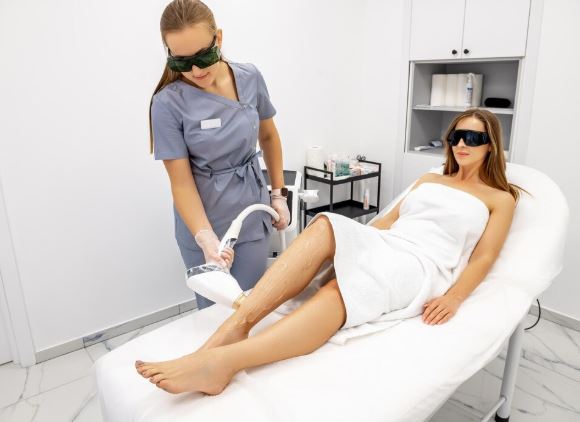Laser hair removal is a method that uses light to remove hair from the body. Many people choose this treatment because they want to get rid of hair for a long time. It is often used on the face, arms, legs, underarms, and bikini area. This method is popular among Laser hair removal men and women. In this article, we will explain how laser hair removal works, what to expect, and the benefits and side effects of the treatment.
How laser hair removal works
Laser hair removal works by using a special light that targets the pigment in the hair. The light travels through the skin and hits the hair root. This heat damages the root and stops the hair from growing again. Because the laser looks for pigment, it works best on dark hair and light skin. However, new tools are being made that work better on all skin types.
Hair grows in three stages: growth, rest, and shedding. The laser is most effective during the growth stage. Since not all hair is in this stage at the same time, several sessions are needed to get the best results. Most people need between six to eight treatments to see smooth, long-term results.
Who can get laser hair removal
Laser hair removal is safe for most people, but not everyone is a good match. People with dark hair and light skin usually get the best results. Those with light-colored hair, such as gray, red, or blonde, may not respond as well to the treatment. People with certain skin conditions or who take some medications should talk to a doctor before starting.
Men often use laser hair removal on areas like the chest, back, neck, and face. Women may choose it for the legs, underarms, bikini area, or face. It is a good option for people who are tired of shaving, waxing, or using creams.
What to expect before the treatment
Before starting, the provider will talk to you about your medical history and check your skin and hair. You will be asked not to pluck, wax, or bleach the hair for several weeks. However, shaving is usually allowed, and in fact, you may be asked to shave the area a day or two before your session.
Avoid sun exposure before the treatment, as tanned skin can lead to side effects. Some people may also be asked to avoid certain skin products that can make the skin more sensitive.
What happens during the treatment
During the session, you will wear special glasses to protect your eyes from the light. The provider may apply a cooling gel or use a device that cools the skin. The laser is then moved over the area being treated. You may feel a light sting or heat, like a rubber band snapping on the skin.
The time it takes depends on the size of the area. Small areas like the upper lip can take just a few minutes, while larger areas like the back or legs can take an hour or more.
What to expect after the treatment
After the treatment, your skin may feel like it has a mild sunburn. Redness and swelling are common, but they usually go away within a day or two. You should avoid sun exposure and use sunscreen on the treated areas. The provider may give you a soothing cream to help with any discomfort.
Hair will not fall out right away. It will shed over the next few days or weeks. New hair may grow, but it will be thinner and lighter than before. With each session, less hair will grow back.
How many treatments are needed
Most people need six to eight sessions spaced about four to six weeks apart. Some people may need touch-up treatments once or twice a year to maintain results. The number of sessions depends on the area being treated, your hair type, and how your body responds to the treatment.
Benefits of laser hair removal
Laser hair removal has many benefits. One of the biggest is that it can reduce hair growth for a long time. After a few sessions, many people see a big difference in how much hair grows back. In some cases, the hair does not come back at all.
Another benefit is that it saves time. You do not have to shave every day or make regular waxing appointments. It also reduces problems like ingrown hairs and razor bumps.
Laser hair removal can also make the skin feel smoother. Since the hair is removed at the root, there is no stubble left behind.
Possible side effects
Like any treatment, laser hair removal has some risks. The most common side effects are redness, swelling, and mild pain. These usually go away quickly. Some people may get blisters, scabs, or changes in skin color. These side effects are rare, especially when the treatment is done by a trained professional.
To reduce risks, it is important to follow all instructions before and after the treatment. Do not expose the skin to the sun and avoid using harsh products on the area.
Cost of laser hair removal
The cost of laser hair removal depends on the size of the area, the number of sessions, and the provider. Small areas like the upper lip are less expensive, while larger areas like the legs or back cost more. Since it is a cosmetic treatment, most health insurance plans do not cover it.
Even though it may seem expensive at first, many people find that it saves money in the long run. They no longer have to buy razors, creams, or pay for waxing.
Choosing the right provider
It is important to choose a skilled and trained provider. Look for someone who has experience and good reviews. Make sure the clinic is clean and uses proper equipment. A good provider will explain the process, answer your questions, and help you understand what to expect.
Do not be afraid to ask about their training, the type of laser they use, and how many treatments they think you will need.
Final thoughts
Laser hair removal is a simple and effective way to reduce unwanted hair. It offers long-lasting results and can make life easier for those who are tired of shaving or waxing. While it may take a few sessions, many people are happy with the results. With the right care and a trained provider, laser hair removal can be a safe and smooth experience






